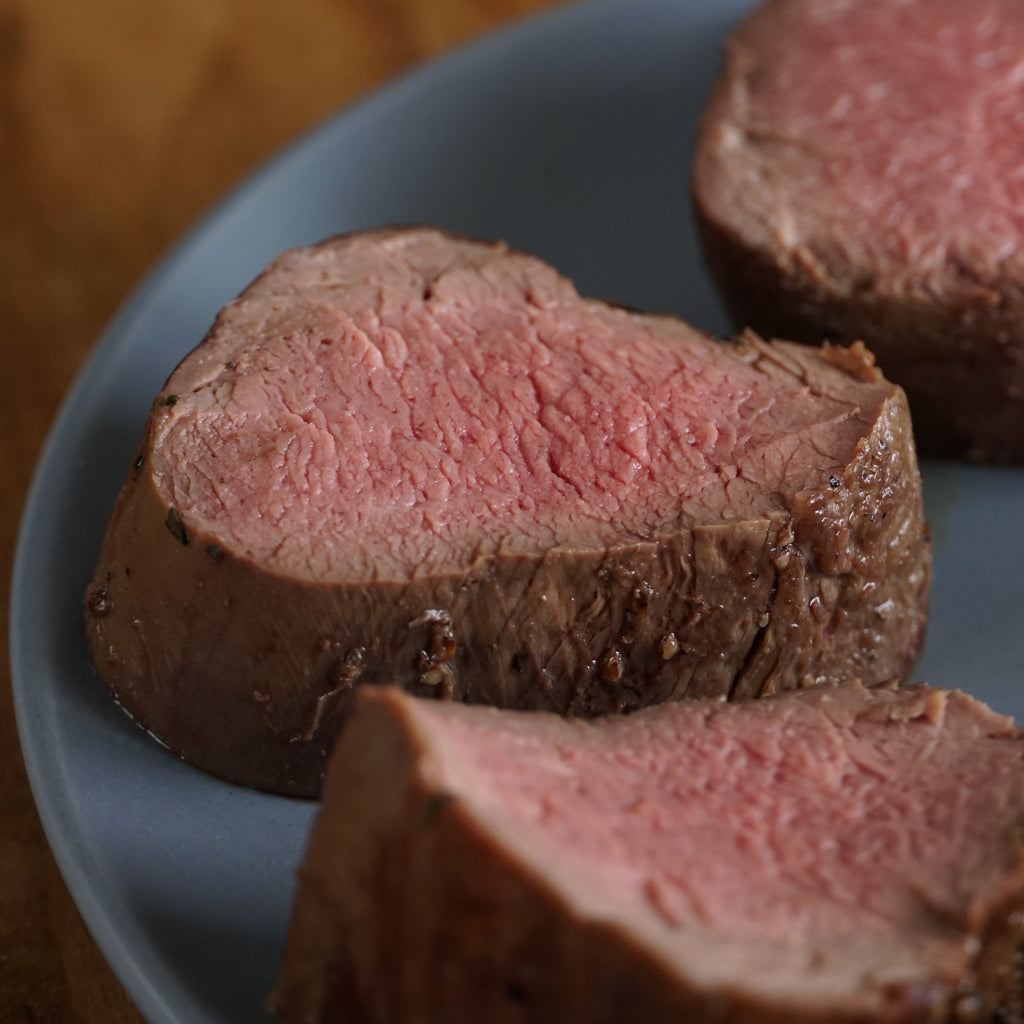












Horizon Farms
Venison Tenderloin Filet (100g-200g)
Choose options
One 100g (3.5oz) or 200g (7oz) tenderloin of venison that is closely trimmed and steak-ready. This top-quality venison tenderloin is exceptionally versatile, allowing you to prepare it in a skillet, oven, or on a grill - as a whole roast or as steak medallions. This tenderloin is fork-tender and will impress you and anyone who has never tried venison before. Cook slowly to medium rare for the best results. See the cooking instructions below.
Venison, the other red meat. Often found on the menus of upscale restaurants throughout the world. It contains less fat than other meats and is rich in protein and iron, which makes it a healthy food choice. Most folks associate venison with gamey odor and tough meat - which occur if the meat is processed incorrectly. Give our free-range venison a chance, it'll change your view on venison.
Our premium quality venison comes from deer that is all-time free-range in New Zealand and Australia. This venison has a subtle delicate flavor and superb tenderness mostly due to a healthy and low-stress life. It goes without saying that the animals have never been treated with antibiotics or growth hormones.
Contents
| Contents | 1 whole tenderloin filet |
| Weight | 100g (3.5oz) or 200g (7oz) |
| Serves | Serves 1-3 depending on the serving style and size selection |
Shipping & Handling
| Shipping | Shipping and delivery is frozen |
| Handling | Keep frozen below -18°C (0°F) |
| Defrosting Time | In the fridge: approx. 24h In ice-water: approx. 4h |
| Cooking Method | Grill, Cast-Iron Skillet, Fry-Pan, Oven |
| Expiration | Frozen: see packaging label (usually more than 3 months) Chilled: Please consume unopened pack within 3 days. |
Details
| Also known as | Deer Tenderloin, Venison Filet, Venison Tenderloin, Venison Steak, Cervena Venison, Chateaubriand |
| Country of Origin | New Zealand, Australia |
| Ingredients | Venison |
| Cut from | Tenderloin |
| Category | Steaks, Roasts |
| Packaging | Vacuum packed |
✔ Free-range on large open pastures in either New Zealand or Australia and treated with respect.
✔ No subtherapeutic use of antibiotics or growth-promoting hormones. No factory farming. These deer live a stress-free and healthy life.
✔ Subtle delicate flavor and superb tenderness.

Venison Tenderloin Filet Recipe Instructions

Completely defrost the tenderloins. Open the pack and pat them dry with a kitchen paper towel.

For a better experience, we recommend removing the silver skin/sinew.

Use a sharp knife and cut closely under the silverskin, then slide towards yourself while holding and stretching the silverskin as seen in the image.

Don't worry about inconsistencies while removing the silverskin - they will be unnoticeable once cooked.

Generously coat with extra virgin quality olive oil. Make sure the frypan gets enough oil as well.

Then season with coarse sea salt and freshly ground coarse black pepper. We like to add dry thyme leaves. Although salt and pepper are sufficient for great quality venison. You can use a seasoning of your choice. Herby seasoning goes very well with venison.

Use a skillet or fry pan. Cook on low/medium and keep turning the tenderloin so it cooks evenly on all sides. Venison tenderloin is very lean and cooks very fast. Please use a thermometer as it is impossible to feel the doneness due to the tenderness of the tenderloin.

Once the internal temperature of the tenderloin has reached 54 degrees Celsius (130 degrees Fahrenheit) quickly remove from the heat and place them on a cutting board.

Cover lightly with aluminum foil and let them rest for about 10 minutes. Juices will flow out so make sure your cutting board has a juice groove. By the way, the red juice is actually myoglobin and not blood.

There are two ways of serving tenderloin. Slices and steak medallions. We prefer steak medallions. They look great and feel luxurious.

Simply slice into thick medallions and serve with vegetables especially sweet potatoes. Mini potatoes cooked with the skin also do a great job. Mushrooms, asparagus, broccoli, or cauliflower are our favorites.

The other serving method is to cut thinner slices and serve similar to a beefsteak. If you are a sauce fan, say no more. Go for the blackberry sauce. Actually, any blackberry jam will do just fine.

This tenderloin is incredibly fork-tender, yes you can cut it with a fork! Enjoy top-quality venison.
